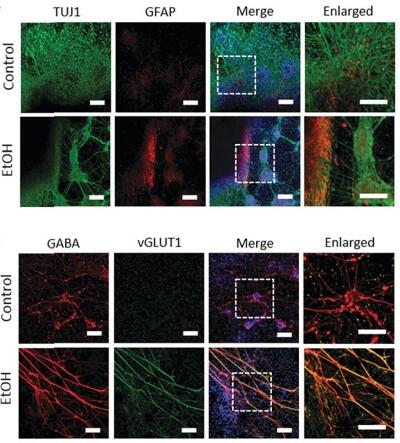Engineering stem cell-derived 3D brain organoids in a perfusable organ-on-a-chip system |
We present a new strategy to generate hiPSCs-derived 3D brain organoids using an organ-on-a-chip system in a controlled manner. This system provides a biomimetic brain microenvironment by incorporating three-dimensional (3D) Matrigel, fluid flow and multicellular architectures of tissues that allows for extended 3D culture, in situ neural differentiation, and organization of brain organoids on a single device. |

|
|
RSC Advances, 2018, 8, 1677-1685 |
Probing impaired neurogenesis in human brain organoids exposed to alcohol |
We propose a human induced pluripotent stem cell (hiPSC)- based 3D brain organoid model, and explore the mechanisms underlying neural dysfunctions in prenatal alcohol exposure (PAE) in vitro. Brain organoids were examined to resemble brain organogenesis in vivo at early stages during gestation, with specific features of neuronal differentiation, brain regionalization, and cortical organization. With ethanol exposure, the brain organoids displayed attenuated neurite outgrowth and skewed neural maturation. |

|
|
Integrative Biology, 2017,9, 968-978 |
Paper supported long-term 3D liver co-culture model for the assessment of hepatotoxic drugs |
We established a simple paper-based scaffold array for creating a 3D liver co-culture model that enabled the assessment of drug induced hepatotoxicity. The hiHeps co-cultured with HUVECs exhibited a 3D like morphology and maintained the liver specific functions of producing albumin and urea for up to 2 months. The low-cost and bioactive paper scaffold could offer great opportunities as 3D in vitro platforms for tissue engineering applications and high-throughput drug testing |

|
|
Toxicology Research, 2018, 7, 13-21 |

 Research Interests
>
正文
Research Interests
>
正文